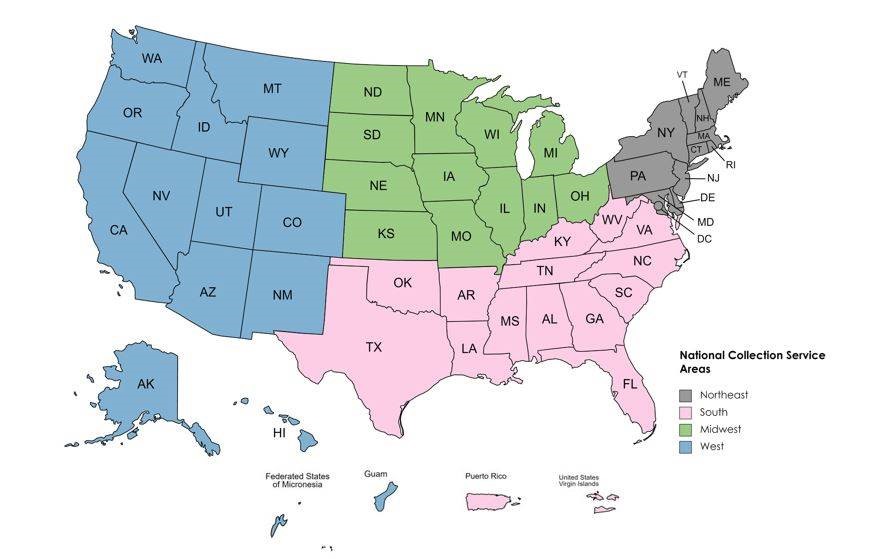National Collection Service Areas (NCSA) group Federal depository libraries into four areas as a means of ensuring geographically dispersed permanent public access to Federal Government information products, sharing resources among depository libraries, and receiving services from GPO’s Library Services and Content Management (LSCM).
In 2015, Joint Committee on Printing (JCP) specified there be no fewer than four geographically dispersed tangible copies of a publication in the Federal Depository Library Program (FDLP). These four geographic areas evolved into what we now call the Midwest, Northeast, South, and West National Collection Service Areas, that are shown in the map below.
 | |
Goals for Developing the NCSA Approach to the FDLP
- Foster collaboration among depository libraries.
- Determine goals and objectives for the NCSA.
- Develop planning documents.
- Ensure adequate numbers of tangible copies are available for access.
- Localize services to depository libraries and NCSAs.
- Improve opportunities for collecting and weeding flexibilities.
NCSA Assumptions
As GPO works to build and develop the NCSAs, these assumptions are recognized:
- Each NCSA will have a steering committee that has periodic meetings.
- The FDLs that receive a particular title may change over time.
- GPO will take responsibility, at its own expense, for relocating portions of depository collections based on need or agreement within an NCSA.
- At least one print copy of each title within an NCSA will be available for delivery to other FDLs using interlibrary loan (ILL) systems.
- At least one tangible copy of each title within an NCSA will be included in a Preservation Steward Partnership agreement.
- Resource sharing and consortia agreements are already in place, and libraries will continue to use them.
- GPO will provide a long-term collection management plan outline for each NCSA to customize, which will include provisions for a Last Copy Policy and procedures.
- Agency printing will continue to decline.
- GPO staff will always be available for assistance and consulting.
Impacts of the National Collection Service Area Approach to the FDLP
Selective Federal depository libraries:
- Provides the potential for more targeted collecting of Federal information to meet local needs as a result of a greater emphasis on cooperative collection development in each region and NCSA.
- Redefines “local” for Federal information collections.
- Strengthens the safety net for tangible materials across a wider area, reducing the need for “just-in-case” collecting.
- Assists selective depository library coordinators in the maintenance of their Federal depository collections.
Regional Federal depository libraries:
- Facilitates management of Federal depository collections in the states or areas regional depositories serve.
- Enables flexibilities for regionals to weed tangible formats of some titles covered by Superintendent of Documents’ authorization of Regional Discard.
- Increases coordination of collections between regional depositories and selectives within the NCSA.
- Allows regional depositories the option of no longer receiving print publications.
- Increases potential for resource sharing to ease the burden of space planning.
Library Services & Content Management:
- Affords a more active role in managing tangible National Collection materials across the FDLP.
- Localizes service to depository libraries and to the service area, including targeted preservation and training opportunities.
- Addresses safety net concerns for guaranteeing permanent public access.
- Provides a framework for monitoring collection levels to ensure an adequate number of copies to meet JCP criteria.
- Provides more flexibility for the allocation of limited distribution titles on the Print Distribution Titles List.
- Creates a way to recognize and address the different needs of depository libraries in each of the NCSAs.
Related Resources
Webinar recordings
- NCSA Meetings (held February 2022)
- Implementation of a Digital FDLP: NCSA Virtual Meetings (September 2023)
- NCSA Collaborative Collection Development Meetings (held November 2023)
- Other recordings related to the PDT List and the Digital FDLP may be found in the FDLP Academy Training Repository by clicking on the “Digital FDLP” subject tag.
Related web pages
- Regional Depository Libraries (guidance article)
- Regional Discards
- Selective Housing Agreements (SHAs) (guidance article)
Questions or comments?
- Contact LSCM via askGPO. Use the category, ‘Other depository library question or issue.’

